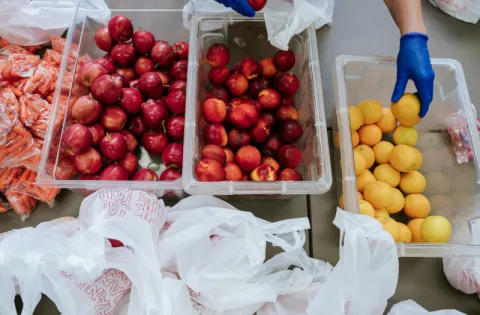The Supplemental Nutrition Assistance Program (SNAP) is one of the most effective ways to combat childhood hunger in America. For decades SNAP benefits have successfully decreased food insecurity and lifted millions of Americans out of poverty by safely and effectively helping families put food on the table.
But there’s a hidden benefit that SNAP provides beyond helping to feed families. It also feeds our economy. As the cost of food, housing, fuel and healthcare continues to increase for American families due to inflation, SNAP is more important than ever.
SNAP benefits feed families
1 in 8 kids in the United States faces hunger. Even more could face hunger if not for the support that SNAP provides to help families purchase food. Currently, 14 million children live in households that rely on SNAP, a program run at the national level by the U.S. Department of Agriculture (USDA). SNAP food stamps offer families a debit-style Electronic Benefits Transfer (EBT) card they can use to buy food at grocery stores.
SNAP supports families with children, seniors, and adults living with disabilities, and is designed to ensure households with the lowest income receive the most benefits. Those benefits adapt to a changing economy, emergencies and disasters, as well as changes within households, such as a new baby or a job loss. This assistance is crucial when family budgets are stretched and jobs and wages are lost.
Even during uncertain times like the COVID-19 pandemic when schools and meal distribution sites were closed and millions of kids were at risk of not receiving the nutrition they needed, SNAP was critical to ensuring children and families had another option to safely access food.
But the benefits of SNAP don’t stop there. It’s a proven stimulus to our nation’s economy.
SNAP benefits are one of the fastest and most effective forms of economic stimulus. That means the program not only helps feed people, but also our economy.
How does it do that? Money spent at local grocery stores and markets leads to more jobs, wages and local economic activity in the community. In fact, every SNAP dollar that households redeem expands the economy by about $1.54. The foods purchased also put money directly in the pockets of farmers and distributors, who in turn can then afford goods, services and food for themselves.
And, since SNAP benefits can only be used to buy food, it frees up money in family budgets to purchase other essential items, like diapers, medicine, or bigger shoes for growing kids.
The best part is that this all happens almost immediately. The vast majority of families spend their benefits before the month ends. Other stimulus programs put dollars in pockets, which people may save or hold onto for later instead of using and stimulating the economy right now.
It's critical for SNAP to be protected and strengthened.
One of the best ways to feed hungry kids is by ensuring their families have the resources to feed themselves. As families continue to face extreme economic hardships and our nation’s economy continues to recover from the pandemic, it’s more important than ever for our country to protect the value of SNAP benefits and maintain and increase access to the program. No Kid Hungry is committed to ensuring SNAP benefits aren’t cut and that more kids across the country can access the nutrition they need through SNAP so they can grow and thrive.
Ways You Can Help
No Kid Hungry is working hard to protect Supplemental Nutrition Assistance Program (SNAP) benefits and you can help! Click here to encourage your Members of Congress to protect and strengthen SNAP.
Learn more about the ways you can help hungry kids or make a donation today.



